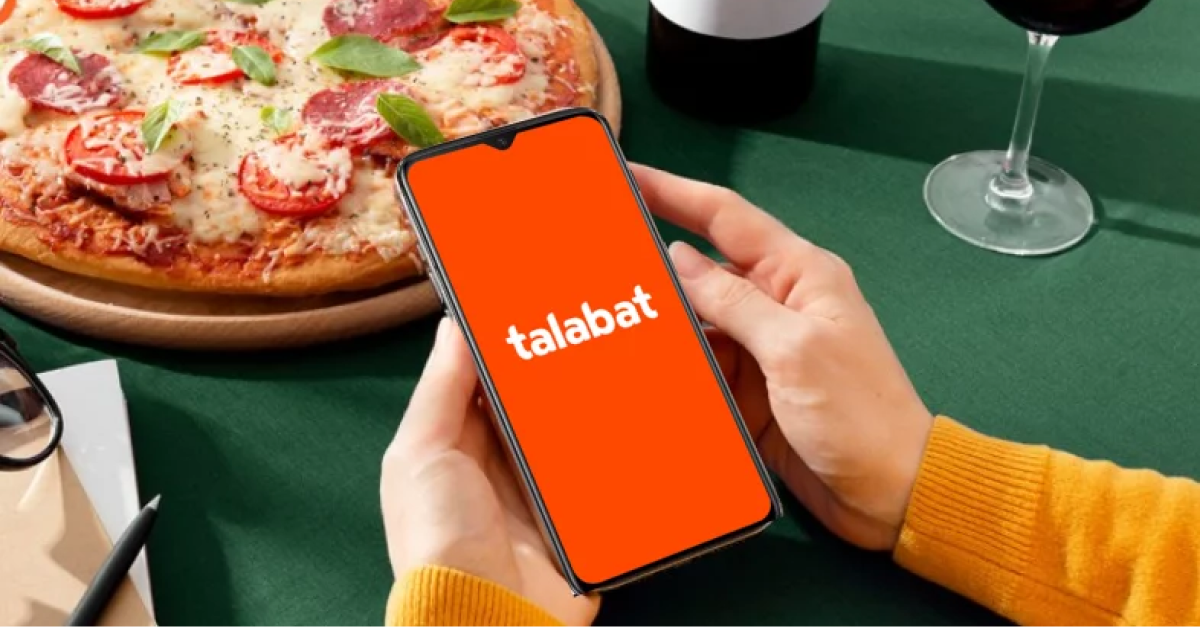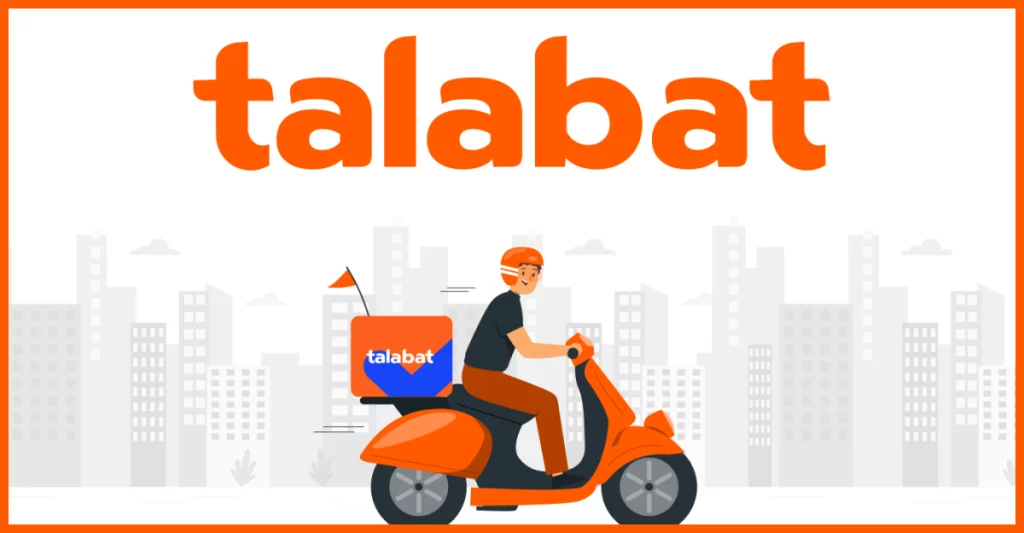When we think about food delivery, Zomato is probably one of the first names that comes to mind in India. But did you know there’s a similar story in the Middle East called Talabat? While Zomato is known for dominating India’s food delivery scene, Talabat has done something quite similar in the Middle East.

So, without any delay, let’s hop into Talabat success story where we will look at how it started, expanded, and turned into the profitable business it is today!
Talabat’s Kuwaiti Roots: How did it start?
Talabat’s journey started in 2004. Talabat was founded by a group of Kuwaiti entrepreneurs who saw the inefficiencies in the traditional way of ordering food over the phone.
Just imagine trying to explain your order, address, and preferences every time you wanted food—sounds cumbersome, right? Talabat’s founders believed that food ordering could be streamlined by moving it online.
Before moving deeper into the Talabat success story, let’s have a look at the company’s profile-
| Particulars | Talabat |
| Operating Industry | E-commerce; Online Food Ordering; Food Delivery; Grocery Delivery |
| Founded | 2004 |
| Area Served | Kuwait, Saudi Arabia, Bahrain, United Arab Emirates, Oman, Qatar, Jordan, Egypt, Iraq |
| Owner | Delivery Hero AG |
| Founder | Abdulaziz Al Loughani |
| CEO | Tomaso Rodriguez |
Talabat’s concept of aggregating various restaurants into one platform resonated with the Kuwaiti audience, especially as the use of the internet and smartphones grew across the region.
Early Struggles: Building Trust in the Digital Age
Like most startups, Talabat didn’t achieve success overnight. In its early days, one of the biggest challenges was convincing both restaurants and customers to trust an online platform. Restaurants were skeptical about integrating their operations with a digital service, while customers were unsure about paying online and sharing their personal details on a website.
To overcome these hurdles, Talabat focused on building trust. They partnered with popular restaurants in Kuwait, which gave the platform credibility.
Gradually, as more people tried the service and had positive experiences, the word spread. Customers started realizing that ordering online wasn’t just convenient—it was quicker and more reliable than calling the restaurant directly.
Expansion: From Kuwait to the Rest of the Middle East
By 2010, Talabat had cemented its position as the leading food delivery platform in Kuwait. But the founders had bigger plans. They expanded Talabat’s operations to other countries in the Gulf Cooperation Council (GCC), including Saudi Arabia, Bahrain, Oman, Qatar, and the UAE. This was a bold move…
Why? You ask.
Well, each market came with its own set of challenges—different tastes, cuisines, and customer expectations—but Talabat adapted by building strong local partnerships and hiring local talent.
Just like Zomato expanded from being a restaurant discovery platform in India to dominating the food delivery scene, Talabat also evolved. They ensured that they partnered with a variety of local restaurants in each region, catering to local tastes and preferences. For instance, in Saudi Arabia, traditional Middle Eastern cuisine is more popular, while in the UAE, there’s a mix of international and regional cuisine.
Look at the following table and you’ll understand how Talabat dominated to Food delivery market in the Middle East-
| Food Delivery Company | Market Share |
| Talabat | 55% |
| Mrsool | 31% |
| Hunder Station | 6% |
| Deliveroo | 4% |
| Careem Now | 3% |
| Uber Eats | 1% |
Do you know there’s another secret behind the dominance of Talabat in the Middle East region? It acquired Zomato in the UAE in March 2019. This was a super brilliant move because it gave a massive edge to Talabat over its competitors. Consequently, its market share also increased.
Acquired by Delivery Hero: A Key Turning Point
One of the most significant milestones in Talabat success story came in 2015, when it was acquired by Rocket Internet’s business unit Global Online Takeaway Group, for $170 million. Later in 2016, Delivery Hero, a global leader in food delivery services, acquired Talabat thereafter it expanded its operations to Jordan, Oman, and Bahrain.
Now, you might be thinking—why does this sound familiar? Well, Zomato, too, attracted significant investment from global giants like Ant Financial, which helped it grow rapidly.
For Talabat, the acquisition by Delivery Hero wasn’t just about money. It brought access to Delivery Hero’s vast experience in running food delivery operations across the globe.
Talabat could now leverage better technology, logistics, and operational expertise, which enabled faster deliveries, better app functionality, and an overall improved customer experience.
Before the acquisition, Talabat’s growth had been steady, but with Delivery Hero’s backing, the company saw a surge in both its restaurant partnerships and customer base.
In short, Delivery Hero’s global resources helped streamline Talabat’s operations, making it more efficient and profitable.
Talabat Business Model: How Talabat makes money?
At the heart of Talabat success story is its business model. Like every online food delivery service, Talabat charges restaurants a commission for every order placed through its platform. This commission can range from 15% to 30% depending on factors like the restaurant’s size, location, and volume of orders. However, what makes Talabat stand out is its ability to adapt its commission structure to suit different markets.
For example, in markets where food delivery is still growing, Talabat might charge a lower commission to attract more restaurants.
On the other hand, in mature markets like the UAE, where the brand is already established, they can afford to charge higher commissions. This flexible approach has allowed Talabat to remain competitive while ensuring steady revenue growth.
Some of the primary revenue streams of Talabat are mentioned in the following table-
| Revenue Source | Description |
| Commission from Restaurants | Percentage of every order, between 15-30% |
| Delivery Fees | Charges from customers for delivering food |
| Advertising and Promotions | Restaurants pay for better visibility on the platform |
| Extra Services for Restaurants | Menu design, photography, marketing campaigns |
As you can see, in addition to commissions, Talabat generates income from delivery fees paid by customers. Depending on the order size and distance, delivery charges can vary, much like Zomato’s delivery fee structure in India.
Additionally, Talabat offers premium services to restaurants, such as marketing packages, which help restaurants gain visibility on the app, further boosting Talabat’s revenue.
In 2023, Talabat generated $194 million in revenue from selling ads on its platform. Its parent company Delivery Hero earned 9.9 billion euros in revenue.
Note: We have thoroughly discussed the business model of two famous food delivery platforms of India i.e. Zomato and Swiggy. Go through the articles for detailed information.
Leveraging Data and Technology
Talabat didn’t just rely on its business model to make money—it also invested heavily in technology. The platform uses AI and data analytics for the following functions-
- Optimize delivery routes
- Predict food preferences
- Reduce delivery times
- Recommend restaurants and dishes based on the customer’s ordering history
This personalized approach not only improves the customer experience but also increases the chances of repeat orders.
Just like how Zomato uses data to personalize user recommendations and improve delivery times, Talabat has mastered the art of using technology to its advantage. It’s no wonder that Talabat now processes millions of orders every year across the Middle East.
Talabat’s Impressive Growth Figures

Let’s look at some numbers to understand the scale of Talabat’s operations-
- Market Share: Talabat commands over 50% market share in the food delivery space across the GCC region. In some countries like Kuwait and Bahrain, its market share exceeds 60%.
- App Downloads: Talabat’s app has been downloaded over 10 million times, similar to Zomato’s download numbers in India.
- Number of Restaurants: Talabat has partnered with over 13,000 restaurants and 24,000 branches across the Middle East, offering a wide variety of cuisines, from local favorites to international chains.
- Deliveries Per Day: Talabat processes hundreds of thousands of orders daily. In 2020 alone, Talabat facilitated over 100 million deliveries, a number comparable to Zomato’s operations in India.
These metrics are a clear indication of Talabat’s stronghold in the market. Much like Zomato in India, Talabat’s scale allows it to negotiate better deals with restaurants and offer customers competitive prices and faster delivery times.
Talabat’s Growth During the COVID-19 Pandemic
The COVID-19 pandemic turned out to be a game-changer for food delivery companies worldwide, and Talabat was no exception. With people staying home and avoiding restaurants, the demand for food delivery skyrocketed. Talabat saw an unprecedented rise in orders during the pandemic, as people relied on delivery services to meet their food needs while staying safe indoors.
Talabat seized this opportunity by introducing “contactless delivery”, promoting hygiene practices, and partnering with grocery stores to offer essentials.
This diversification into grocery delivery helped Talabat to stay relevant and profitable during challenging times.
Competition and Challenges: Staying on Top
Just like Zomato faces competition from Swiggy in India, Talabat has its own set of competitors in the Middle East. The following platforms offered stiff competition to Talabat-
- Careem Now
- Hunger Station
- Mrsool
- Deliveroo
- Uber Eats
- Zomato UAE
As told before, Talabat acquired Zomato UAE to increase its market share. Uber Eats shut down its operations in the Middle East due to rising losses and cutthroat competition from large players.
One of the ways Talabat stays ahead is by maintaining strong relationships with restaurants and ensuring faster delivery times.
However, competition isn’t the only challenge. Talabat also has to deal with regulatory hurdles, rising operational costs, and the ever-changing preferences of customers. But so far, the company has managed to navigate these challenges by adapting its strategies, expanding its services, and focusing on customer satisfaction.
The Road Ahead: What’s Next for Talabat?
Much like Zomato’s plans for expansion and diversification, Talabat has its eyes set on new horizons. The company is exploring new verticals such as grocery delivery and has already started rolling out Talabat Mart, a quick-commerce service that promises to deliver groceries in under 30 minutes. This move mirrors Zomato’s acquisition of Blinkit in India to capitalize on the growing demand for fast grocery deliveries.
Talabat is also focusing on sustainability. The company has introduced initiatives to reduce plastic waste, encouraging restaurants to use eco-friendly packaging.
From its humble beginnings in Kuwait to its expansion across the Middle East, Talabat’s growth has been nothing short of impressive. By drawing comparisons with Zomato, it’s easy to see how Talabat’s strategies resonate with what we know about food delivery platforms in India.
One thing is certain—Talabat’s success story is far from over!

